"Joplin at the Turn of the Century"
Introduction
Text-to-speech Audio
Thomas Hart Benton completed his final mural in Missouri in 1972. Originally located in the old Municipal Building, Joplin at the Turn of the Century marked his first return to the town in nearly 70 years. The scene depicts the people of his home region as he remembered them from his childhood. In addition to his usual preparations, Benton used photographs and local rocks to get every element correct. The mural now hangs in City Hall. Visitors can see the painting and the Evolution of a Mural exhibit during business hours.
Images
Joplin at the Turn of the Century (1896–1906)

Backstory and Context
Text-to-speech Audio
In 1971, Joplin hired Thomas Hart Benton to create a mural to celebrate the city’s 100th anniversary. Benton immediately decided to depict the range of social classes he observed in his youth. He used the resources available to do justice to reality. Despite the fact that he was nearing the end of his life, Benton worked on the mural with the same dedication he always had.
Benton focused on the different types of people he saw in Joplin between 1896 and 1906. Starting at the left, an upper-class woman stands dressed in a fancy dress and hat and carrying a parasol to shade her from the sun. Below her, two men play poker. Benton’s old favorite saloon, House of Lords, is in the background. A young Benton sits drawing cartoons while newcomers arrive in a wagon with a “Joplin or Bust” sign on the back. Finally, Benton depicted the town’s industry by including laborers and mining equipment. A small sign points in the direction of Neosho. Benton wanted to represent Joplin’s duality. He believed that “multiple meanings are characteristic of all pictures.”[1] While there was honest work and industry, some people made their money gambling. The prim woman and the laborers are on opposite sides of the mural. People could find whatever meaning they wished in the mural. However, they could not deny that all these people gave the city its character.
Once again, Benton made numerous drawings, studies, and three-dimensional models before starting the final piece. His most helpful assets, besides his memory, were pictures of Joplin around 1900. His friends found photographs so that Benton could represent the buildings and people in his mind authentically. He also used local rocks and minerals from the Joplin Mineral Museum to make the geology accurate. The minerals at the miners’ feet almost sparkle. Despite his age, Benton would not do the job halfway. He took pride in his work until the end.
Joplin unveiled the mural in 1973, the city’s centennial year. The piece held a special place in Benton’s heart. As he said, “Every old codger likes, now and then, to recall his youth and, if he can get anybody to pay attention, tell stories about it.”[2] Joplin was lucky that its anniversary year was not any later. On January 19, 1975, Benton died of a heart attack in his home studio. He was 85 years old. The artist had just finished his final mural, The Sources of Country Music, and was about to add his signature. The Country Music Hall of Fame and Museum in Nashville, Tennessee, only just received the work it had commissioned.
Benton’s Joplin mural contains many of his characteristic elements. The artist focused much of his work on Midwestern laborers and rural life. At the same time, his experiences in Washington, DC, Paris, and New York made him interested in the upper class. He did not shy away from highlighting vice and the unappealing parts of life. His dedication to depicting the world realistically led him to do extensive research. While Benton was controversial in his time, his work has continued to survive and influence other artists, as Ken Burn’s 1988 documentary shows. Benton’s work directly contrasts the more abstract modern art that coastal painters such as Jackson Pollock made during the 20th century. Thomas Hart Benton set a high standard of care for the Midwest with his dedication to Regionalism. Examining his art can help viewers better understand the duality of their country and region.
Sources
- Warten, Thomas Hart Benton: A Personal Commemorative, 35.
- Warten, Thomas Hart Benton: A Personal Commemorative, 31.
Warten, Mary Curtis. Thomas Hart Benton: A Personal Commemorative. Joplin, MO. The Joplin Council for the Arts, 1973.
Wolff, Justin. Thomas Hart Benton: A Life. New York. Farrar, Straus and Giroux, 2012.
https://connect2culture.org/arts-and-culture/public-art/joplin-at-the-turn-of-the-century/
